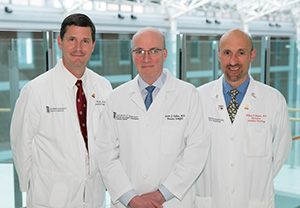Jan. 22, 2020:
The University of Maryland Marlene and Stewart Greenebaum Comprehensive Cancer Center (UMGCCC) has joined the Big Ten Cancer Research Consortium (Big Ten CRC). The Big Ten CRC was created in 2013 to transform the conduct of cancer research through collaborative, hypothesis-driven, highly translational oncology trials that leverage the scientific and clinical expertise of Big Ten universities. Its membership now includes the cancer centers of all Big Ten universities.
 Located in Baltimore, Md., UMGCCC offers innovative approaches to diagnosing and treating all types of cancer, conducts cutting-edge research to bring the latest advances in cancer treatment directly to patients in Maryland and beyond, and provides cancer screening and patient education services. It is one of 51 National Cancer Institute (NCI)-designated comprehensive cancer centers in the nation, recognized for its excellence in patient care and multidisciplinary translational research program.
Located in Baltimore, Md., UMGCCC offers innovative approaches to diagnosing and treating all types of cancer, conducts cutting-edge research to bring the latest advances in cancer treatment directly to patients in Maryland and beyond, and provides cancer screening and patient education services. It is one of 51 National Cancer Institute (NCI)-designated comprehensive cancer centers in the nation, recognized for its excellence in patient care and multidisciplinary translational research program.
“We are delighted to join the Big Ten Cancer Research Consortium and look forward to forging new research partnerships with colleagues at other top academic institutions who share our commitment to developing effective new treatments for patients – and ultimately defeating cancer,” said UMGCCC Director Kevin J. Cullen, MD, the Marlene and Stewart Greenebaum Distinguished Professor in Oncology at the University of Maryland School of Medicine. “Membership in the consortium offers our investigators a tremendous opportunity for collaboration.”
 More than 200 physicians and scientists work together at the cancer center, a joint entity of the University of Maryland Medical Center and the University of Maryland School of Medicine. In recent years, UMGCCC has pioneered advances in cancer treatment, including the development of aromatase inhibitors to treat breast cancer by the late Angela Brodie, PhD; the invention of the GammaPod™, a new radiation treatment option for early-stage breast cancer that can reduce the number of treatments and spare healthy tissue from radiation; and the development of promising new drug compounds and immunotherapies, such as a next-generation chimeric antigen receptor (CAR) T-cell therapy.
More than 200 physicians and scientists work together at the cancer center, a joint entity of the University of Maryland Medical Center and the University of Maryland School of Medicine. In recent years, UMGCCC has pioneered advances in cancer treatment, including the development of aromatase inhibitors to treat breast cancer by the late Angela Brodie, PhD; the invention of the GammaPod™, a new radiation treatment option for early-stage breast cancer that can reduce the number of treatments and spare healthy tissue from radiation; and the development of promising new drug compounds and immunotherapies, such as a next-generation chimeric antigen receptor (CAR) T-cell therapy.
“With the University of Maryland Marlene and Stewart Greenebaum Comprehensive Cancer Center joining the Big Ten Cancer Research Consortium, we now have all of the Big Ten universities united in our collective fight against cancer,” said Patrick J. Loehrer, MD, director of the Indiana University Melvin and Bren Simon Cancer. “We’re harnessing the combined strength of these cancer centers to bring discoveries made in the labs to the bedsides of patients to improve lives. This ‘bench-to-bedside’ approach benefits patients as researchers and physicians work together to find better ways to prevent, diagnose, and treat cancer.”
More than 300 researchers are currently active in Big Ten CRC Clinical Trial Working Groups, where researchers present their study concepts, receive valuable scientific feedback, and identify participating institutions to open their studies. To date, the consortium has launched 25 clinical trials and enrolled more than 500 patient volunteers.
 “Big Ten cancer researchers have created a unique opportunity for collaboration through the Big Ten CRC,” said Ruth O’Regan, MD, Chief Scientific Officer of the Big Ten CRC and Division Head of Hematology, Medical Oncology, and Palliative Care at the University of Wisconsin School of Medicine and Public Health. “We heartily welcome University of Maryland clinical researchers and scientists to the consortium, and look forward to the advancements our work together will bring.”
“Big Ten cancer researchers have created a unique opportunity for collaboration through the Big Ten CRC,” said Ruth O’Regan, MD, Chief Scientific Officer of the Big Ten CRC and Division Head of Hematology, Medical Oncology, and Palliative Care at the University of Wisconsin School of Medicine and Public Health. “We heartily welcome University of Maryland clinical researchers and scientists to the consortium, and look forward to the advancements our work together will bring.”
The Big Ten CRC is just one of many examples of Big Ten Conference athletic rivals working together academically to tackle some of the biggest challenges in academic and scientific research.
“The addition of the University of Maryland and the progress made by the Big Ten Cancer Research Consortium shows what can be accomplished using the power and reach of the Big Ten brand to collaborate around significant issues such as cancer research,” said Big Ten Commissioner Kevin Warren. “The inclusion of all 14 member institutions in the Big Ten CRC is a testament to the culture of collaboration that has existed within the Big Ten Conference for more than a century.”
Members of the Big Ten Cancer Research Consortium include:
- University of Illinois Cancer Center (University of Illinois at Chicago)
- The Cancer Center at Illinois (University of Illinois at Urbana-Champaign)
- Indiana University Melvin and Bren Simon Cancer Center
- Holden Comprehensive Cancer Center, University of Iowa
- University of Maryland Marlene and Stewart Greenebaum Comprehensive Cancer Center
- University of Michigan Rogel Cancer Center
- Michigan State University Breslin Cancer Center
- Masonic Cancer Center, University of Minnesota
- Fred & Pamela Buffett Cancer Center (University of Nebraska)
- Robert H. Lurie Comprehensive Cancer Center of Northwestern University
- The Ohio State University Comprehensive Cancer Center – Arthur G. James Cancer Hospital and Richard J. Solove Research Institute
- Penn State Cancer Institute
- Purdue University Center for Cancer Research
- Rutgers Cancer Institute of New Jersey
- University of Wisconsin Carbone Cancer Center
For more information, visit www.bigtencrc.org.
About the Big Ten Conference: The Big Ten Conference is an association of world-class universities whose member institutions share a common mission of research, graduate, professional and undergraduate teaching and public service. Founded in 1896, the Big Ten has sustained a comprehensive set of shared practices and policies that enforce the priority of academics in the lives of students competing in intercollegiate athletics and emphasize the values of integrity, fairness and competitiveness. The broad-based programs of the 14 Big Ten institutions will provide over $200 million in direct financial support to more than 9,800 students for more than 11,000 participation opportunities on 350 teams in 42 different sports. The Big Ten sponsors 28 official conference sports, 14 for men and 14 for women, including the addition of men’s ice hockey and men’s and women’s lacrosse since 2013. For more information, visit www.bigten.org.
About the University of Maryland Marlene and Stewart Greenebaum Comprehensive Cancer Center: The University of Maryland Marlene and Stewart Greenebaum Comprehensive Cancer Center is a National Cancer Institute-designated comprehensive cancer center in Baltimore. The center is a joint entity of the University of Maryland Medical Center and University of Maryland School of Medicine. It offers a multidisciplinary approach to treating all types of cancer and has an active cancer research program. It is ranked among the top 20 cancer programs in the nation by U.S. News & World Report. www.umgccc.org.
















Subscribe to the Big Ten CRC Newsletter X
X Facebook
Facebook YouTube
YouTube